Interpretation of AHERA Sampling (40 CFR 763.86) On a Construction Site
Question:
Under 763.86 (c), we determined that the standard for bulk sampling of miscellaneous materials was to collect 3 samples per homogeneous area (“in a manner sufficient to determine whether material is ACM or not…”) and that an accredited inspector shall collect these bulk samples.
The materials that we work with (concrete, conduit and other non-friable, fibrous or cementitious material) are not typically considered ACBM, nor are they typically friable unless disturbed, so 763.86(c) does not seem to apply. However, NESHAP and OSHA regulations may still require sampling and analysis of these materials and refers back to the AHERA sampling protocol.
Are you able to cite the regulations and how they all tie back or together?
Answer:
First of all, it is 763.86(d) that would apply in your case, not (c). Subparagraph (c) is about sampling friable miscellaneous material such as acoustical ceiling tile. Subparagraph (d) is about sampling non-friable surfacing or non-friable miscellaneous such as transite conduit, AC pipe, etc. As far as regulatory citations, you have the AHERA regulation.
Refer to 763.86 and .87. You mentioned the NESHAP regulation in your question. See 40 CFR 61.145 for the requirement to inspect and 61.150 for waste disposal. You also mentioned OSHA. The OSHA standard that applies here is the construction standard at 29 CFR 1926.1101. OSHA does not require an asbestos inspection (this is immaterial, as NESHAP does).
OSHA requires due diligence (responsibility). Paragraph .1101(k) “Communication of Hazards” would be your reference here. As far as how these regulations “tie together”, they really don’t. Each one is independent and requires compliance.
In your situation, NESHAP would apply and references AHERA. Use 40 CFR 763.86 (d) and 763.87 as guidance. AHERA does not give a minimum number of samples to collect, so always assume 3. Follow 763.87 for analysis (at a minimum).
If the analysis results in ACM, or if you assume ACM rather than sample and analyze, OSHA will apply. Your disturbance and repair work would probably be Class III Work (29 CFR 1926.1101(g)(9)) or perhaps Class II Work at 1101(g)(8) depending on the amount of work and debris generated.
OSHA requires training for either class of work, so reference 1101(k)(9). In your case, the minimum amount of training would be 4 hours in either case.
For more detail on the above answers, contact J at [email protected] or Bill at [email protected] .
Image Attribution: Park taeho, CC BY-SA 4.0 <https://creativecommons.org/licenses/by-sa/4.0>, via Wikimedia Commons

© The Asbestos Institute | All rights reserved